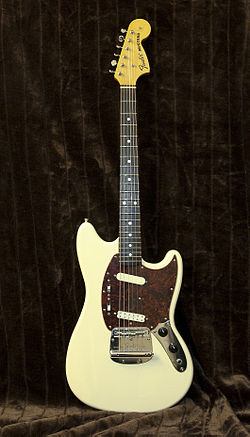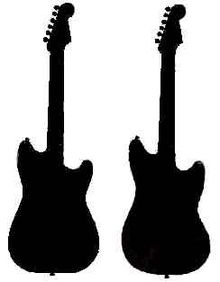- Fender Mustang
-
Fender Mustang 
Fender Mustang in Vintage White with an aftermarket bridge pickup.Manufacturer Fender Period 1964-1982, 1990-present Construction Body type Solid Neck joint Bolt-on Scale 22.5" or 24" Woods Body Poplar, Basswood, Alder, Ash, Mahogany Neck Maple Fretboard Rosewood, Maple Hardware Bridge Fender Dynamic Vibrato Pickup(s) 2 single coil Colors available Daphne Blue, Dakota Red, Olympic White, Competition Red, Competition Blue, Competition Orange, Sunburst The Fender Mustang is an electric guitar by the Fender Musical Instruments Corporation, introduced in 1964 as the basis of a major redesign of Fender's student models then consisting of the Musicmaster and Duo-Sonic. It was produced until 1982 and reissued in 1990.
In the 1960s, it was used in Surf music. It attained cult status in the 1990s largely as a result of its use by a number of alternative rock bands. Early examples are generally seen as the most collectible of all the short-scale Fender guitars.
The Mustang features two single-coil pickups with an unusual switching configuration, and a unique tremolo arm. It was originally available in two scale lengths.
Fender also issued a series of amplifiers named the Mustang in 2010.
Contents
Model history
In August 1964, Fender released a new guitar called the Mustang, an economy model intended for more advanced students and featuring a new, original Leo Fender-designed tremolo arm.
 Profiles of a 1965 Musicmaster (left) and a Mustang, both with 22.5" necks and Musicmaster headstocks.
Profiles of a 1965 Musicmaster (left) and a Mustang, both with 22.5" necks and Musicmaster headstocks.
The Mustang has an offset waist, reminiscent of the Jazzmaster, but its overall styling closely followed the existing student models the Musicmaster and Duo-Sonic, the slight waist offset being the main change. After the release of the Mustang, the Musicmaster and Duo-Sonic were redesigned using the Mustang body; These were branded the Musicmaster II and Duo-Sonic II but the decals were not consistently applied.
All three Mustang-bodied models (Mustang, Musicmaster II and Duo-Sonic II) were offered with optionally the 21 fret 22.5-inch (or 3/4 scale) neck, or a 22 fret 24-inch neck, but the 24-inch was overwhelmingly more popular and 3/4 scale examples are rare. A 24-inch scale is still relatively short, the same as the Fender Jaguar but a full inch and a half shorter than the Stratocaster and three-quarters of an inch shorter than the Gibson Les Paul. The short scale may improve ease of use for people with small hands, and also enhances the ability to use the tremolo arm for upbends.
This short scale, combined with a unique and extremely direct tremolo arm would make the Mustang a cult guitar in the 1990s. Before that, its relatively low cost and marketing as a student guitar made it an obvious candidate for aftermarket upgrades, particularly pickup changes and also amateur finishes. Its wiring with the original pickups also led itself to custom modifications.
In 1966 Fender issued the Fender Mustang Bass. A new bass body was designed for this with a similar offset body style to the Mustang guitar, and a short (30-inch) scale was used.
In 1969 Fender released the "Competition" Mustang with a "racing stripe" paint job and painted headstocks. Body contours were also added at this time. The competition mustangs came in Competition Red, Competition Blue(Known as Competition Burgandy in the Fender catalog), and Competition Orange. This paint scheme was heavily influenced by the Shelby Mustang cars of the late 60s.
In 1982 Fender discontinued both the Mustang and the Musicmaster II. These were the last of the offset student models to be made. Fender replaced the Mustang line with the short-lived Fender Bullet line of guitars and basses before relegating production of their student guitars to their Squier division.
Re-issues since the 1990s
In 1990 Fender re-issued the Mustang, largely as a result of the vintage movement prevalent at the time. Among grunge and punk rock guitarists, Fender's discontinued models (budget models such as the Duo-Sonic and high-end models such as the Jazzmaster and Jaguar) had become extremely popular. Such models had Fender quality, but were less expensive secondhand than vintage Stratocasters and Telecasters.
The reissued Mustang is made in Japan and available in only the 24-inch scale. While the original Mustangs used mostly poplar wood for the body (with some rarely documented cases of mahogany, MG-72 Mustang reissues are made of the similar basswood, the newer MG-65 reissues revert to the original poplar. The natural-finished MG-77 reissue is made of ash.
In 2011 Fender released a new Mustang model in the so-called Pawn Shop series, called the Mustang Special. The model features an offset Mustang body shape and a 24-inch scale neck, but with humbucking pickups and a hard-tail Stratocaster bridge.[1]
Electronics
The Mustang has two angled single-coil pickups, each with an adjacent on-off-on switch, and a master tone and volume control.
The Mustang is unusual in having neither a pickup selector nor a circuit selector switch, instead just using the two pickup switches to allow the pickups to be used either singly or in parallel. The second on position reverses the phase of the selected pickup, allowing the pickups to be either in or out of phase when in parallel. This phasing option was also unusual for 1964.
It also meant that, as both pickups were floating with respect to ground, it was possible to modify the wiring to put the pickups into series either in or out of phase without excessive noise. The unusual switching could also be replaced by a conventional pickup change switch using the unused body routing already provided for compatibility with the Duo-Sonic, requiring only modification of the pickguard, and freeing the two eight-terminal pickup switches for other uses. As with many student guitars, aftermarket pickup additions and changes are commonly found in many vintage examples.
Tremolo arm
The Mustang introduced the Fender Dynamic Vibrato tailpiece, which together with a floating bridge forms the Mustang trem system. The floating bridge concept is common to the Fender floating tremolo developed for the Jazzmaster, but on the Mustang the saddles have only a single string slot, while on other Fender guitars there are multiple slots to allow limited adjustment of the string spacing.
The tailpiece was unique when introduced and remains the most unusual feature of the Mustang; Only the Jag-Stang and Fender Custom (Maverick) share this particular mechanism. While not nearly so popular as the Stratocaster synchronized tremolo, some guitarists prefer it over all other tremolo mechanisms. But a lot of guitarists also claim that the tremolo is too sensitive. Most notably, Fender incorporated it in the custom design which became the Jag-Stang.
No previous Fender student guitar had a tremolo system at all, and the subsequent Fender Bronco used a completely different mechanism, without a floating bridge.
The Mustang was the last of the Fender floating bridge models to be withdrawn, and the first to be reissued. Mustangs have maintained a popular following in Japan.
Colours
The Fender Mustang was originally produced in Daphne Blue, Olympic White, and Dakota Red in 1965-1968. In 1969, Fender switched to the "Competition Colors," this consisted of Competition Blue, Competition Red, and Competition Orange. These Competition Mustangs are the only original Fender guitars to be produced with these "Racing stripes" which make them very collectable. The competition Mustangs produced from 1969 to mid 1970 came with a matching headstocks, from then on, Fender Mustangs came with Fender's standard wood colored headstock. The matching headstock models seem to be more desirable with collectors than the non matching models. Over the years, the Mustang has been produced in the following colors: sunburst, black, olympic white, sonic blue, daphne blue, Dakota red, competition blue, competition red, competition orange, natural, mocha brown, wine red transparent, Antigua,and candy apple.
Notable Mustang players
- Adrian Belew
- Rob Buck (10,000 Maniacs)
- David Byrne (Talking Heads)
- Graham Coxon (Blur)
- John Fogerty (Creedence Clearwater Revival)
- PJ Harvey
- Kelly Jones (Stereophonics)
- Alan Lancaster (Status Quo)
- Magic Slim
- John McLaughlin
- Thurston Moore (Sonic Youth)
- Buzz Osborne (The Melvins)
- Liz Phair
- Lee Ranaldo (Sonic Youth)
See also
- Fender Musical Instruments Corporation
- Mustang Bass
External links
References
- ^ Ross, Michael; James Nash (September 2011). "Fender Pawnshop Series and 60th Anniversary Telecaster". Guitar Player: pp. 108–14.
Electric guitars Minor modelsCoronado · Custom · Cyclone · Electric XII · Esquire · Jag-Stang · Katana · Lead Series · Marauder · Performer · Prodigy · Showmaster · Starcaster · ToronadoStudent modelsSteel guitarsAcoustic guitars Squier guitars See also Categories:- Fender electric guitars
Wikimedia Foundation. 2010.



